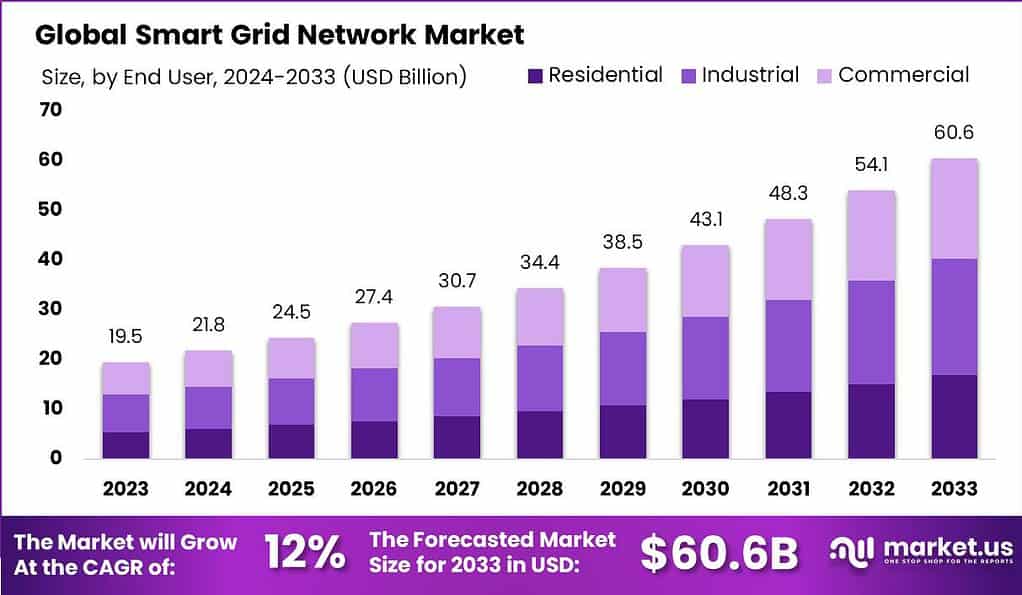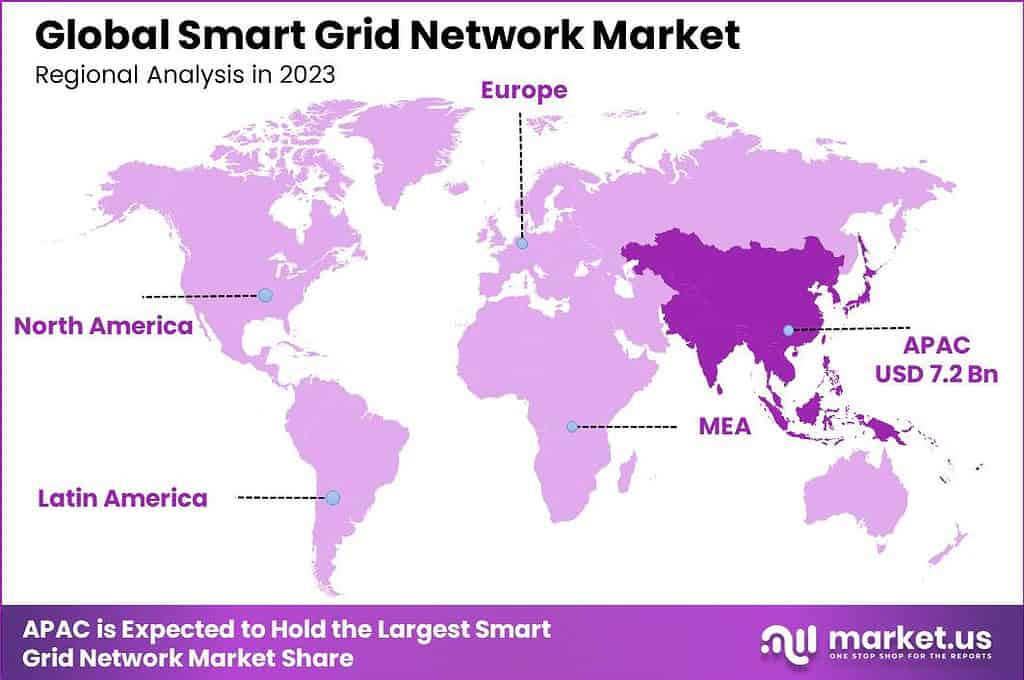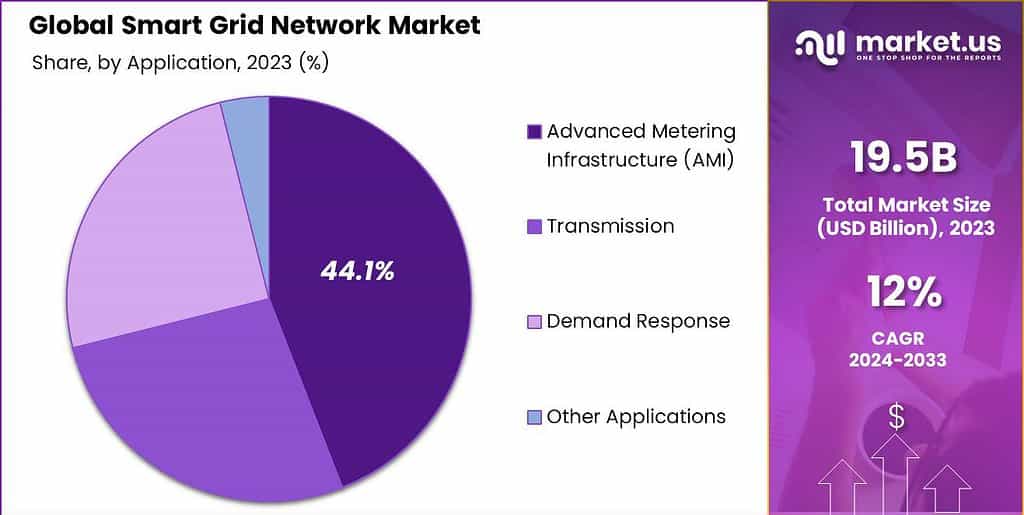Table of Contents
Report Overview
The Global Smart Grid Network Market is projected to experience significant growth, reaching an estimated value of USD 60.6 billion by 2033, up from USD 19.5 billion in 2023. This growth reflects a robust compound annual growth rate (CAGR) of 12.00% during the forecast period from 2024 to 2033. The expansion of smart grid technologies, driven by the increasing need for energy efficiency and modernization of electrical infrastructure, plays a crucial role in this market trajectory.
The Smart Grid Network market is witnessing a remarkable transformation driven primarily by the global surge in energy demand and the imperative to enhance the efficiency and reliability of energy distribution. More people, growing cities, and a shift towards digital lifestyles have put immense pressure on existing grid infrastructures, revealing their limitations in handling modern energy needs. As a solution, smart grids provide dynamic, interconnected networks leveraging advanced communication and automation to address fluctuating demands and prevent costly outages, resulting in a more dependable energy landscape.

Demand for smart grid networks is intensifying as industries, governments, and consumers recognize the necessity for cleaner, smarter energy systems. The shift is strongly fueled by increasing investments in renewables, electrification of transport, and global targets for carbon reduction. Households and enterprises need uninterrupted, quality power, so the promise of reduced blackout frequency and faster system recovery is highly attractive.
In developing economies, especially, the integration of renewables and the rollout of smart meters further escalate demand, supporting stable yet flexible energy ecosystems that can adapt to rapidly changing consumption patterns. Investment opportunities in the smart grid market are particularly robust, fueled by strong policy backing and ambitious infrastructure upgrades in key regions.
Governments, international agencies, and the private sector are pouring capital into modernizing grid equipment, developing digital tools, and scaling up distributed energy resources. The most promising growth is seen in equipment manufacturing, software solutions, and downstream sectors where regulatory burdens are lighter and innovation cycles are faster. As nations look to double their grid investments within a decade, there’s a clear shift toward sustainable, cost-effective solutions supporting the transition to net-zero targets.
Smart Grid Network Statistics
- The global market is projected to grow from USD 19.5 Billion in 2023 to approximately USD 60.6 Billion by 2033, advancing at a strong CAGR of 12.00%.
- In 2023, the Advanced Metering Infrastructure (AMI) segment led the market, accounting for over 44.1% share, driven by rising adoption of smart meters for consumption tracking and load balancing.
- The Industrial sector held a leading 38.5% share by end-use, as manufacturers adopt intelligent grid systems to manage power quality, operational efficiency, and downtime reduction.
- The Asia-Pacific region dominated globally with more than 37.0% share in 2023, generating USD 7.2 Billion in revenue. This growth was supported by large-scale grid digitization programs and growing energy demand in emerging economies.
Report Scope
| Report Features | Description |
|---|---|
| Market Value (2023) | USD 19.5 Bn |
| Forecast Revenue (2033) | USD 60.6 Bn |
| CAGR (2024-2033) | 12.00% |
| Base Year for Estimation | 2023 |
| Historic Period | 2019-2022 |
| Forecast Period | 2024-2033 |
Regional Analysis
In 2023, the Asia-Pacific region maintained a dominant position in the smart grid network market, capturing more than 37.0% of the total market share and generating USD 7.2 billion in revenue. This leadership can be attributed to the region’s heavy investments in smart grid infrastructure, alongside government initiatives aimed at improving energy distribution systems and integrating renewable energy sources.

Application Analysis – AMI: 44.1%
In 2023, the Advanced Metering Infrastructure (AMI) segment held a dominant share of 44.1% in the Smart Grid Network market. AMI systems are essential for enabling two-way communication between utilities and consumers, facilitating real-time data collection, and improving energy management. These systems allow for accurate billing, energy consumption monitoring, and immediate detection of outages. The growing need for efficient, automated energy consumption management across residential, commercial, and industrial sectors has significantly contributed to the growth of the AMI segment.
The increasing adoption of smart meters and the push for greater energy efficiency are key drivers behind AMI’s market dominance. These technologies not only enhance the customer experience but also help utilities optimize grid operations, contributing to smarter, more sustainable energy systems.

End-User – Industrial: 38.5%
The Industrial segment was the leading contributor to the market, accounting for 38.5% of the total market share in 2023. Industrial users are adopting smart grid technologies to enhance energy efficiency, reduce operational costs, and ensure reliable power supply. These systems provide real-time monitoring, predictive maintenance, and the ability to manage energy demand across large facilities and factories. The increased use of IoT and automation technologies in industrial applications further drives the demand for advanced grid solutions.
As industries scale their operations and integrate renewable energy sources, the need for intelligent, adaptable grid systems has grown, making industrial customers a key segment for smart grid solutions. Enhanced grid reliability and optimization play a critical role in improving operational efficiency and supporting sustainability goals in industrial sectors.
By Region: Asia-Pacific – 37.0%
The Asia-Pacific region led the global Smart Grid Network market in 2023, capturing 37.0% of the market share and generating revenue of USD 7.2 billion. This dominance can be attributed to rapid urbanization, growing energy demand, and government initiatives aimed at modernizing energy infrastructure across the region. Countries such as China, India, and Japan are heavily investing in smart grid technologies to integrate renewable energy sources, enhance grid reliability, and meet their climate targets.
The region’s large industrial base, coupled with a growing focus on energy efficiency and smart city initiatives, has propelled the demand for smart grid networks. Additionally, favorable government policies and subsidies for smart infrastructure development are expected to sustain the region’s leading position in the market.
Key Market Segments
By Application
- Advanced Metering Infrastructure (AMI)
- Transmission
- Demand Response
- Other Applications
By End-User
- Residential
- Commercial
- Industrial
Top Key Players in the Market
- Siemens AG
- ABB Group
- Schneider Electric SE
- Cisco Systems, Inc.
- Oracle Corporation
- General Electric Company
- Eaton Corporation plc
- Landis+Gyr
- Honeywell International Inc.
- Itron, Inc.
- Other Key Players
Discuss your needs with our analyst
Please share your requirements with more details so our analyst can check if they can solve your problem(s)



